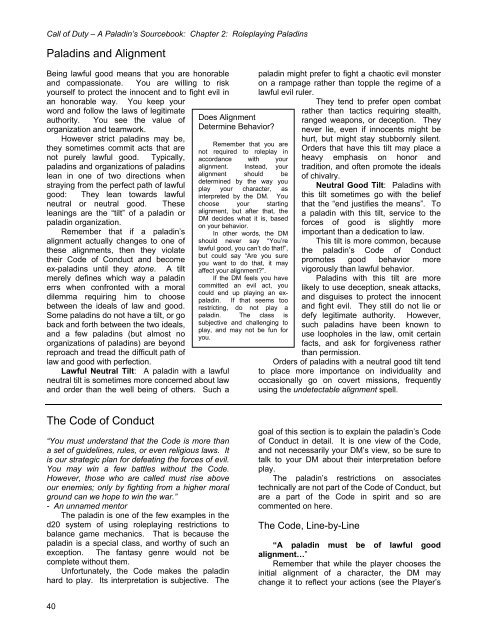DnD/Class Handbooks/Paladins/Call of Duty - Paladin
DnD/Class Handbooks/Paladins/Call of Duty - Paladin
DnD/Class Handbooks/Paladins/Call of Duty - Paladin
You also want an ePaper? Increase the reach of your titles
YUMPU automatically turns print PDFs into web optimized ePapers that Google loves.
<strong>Call</strong> <strong>of</strong> <strong>Duty</strong> – A <strong>Paladin</strong>’s Sourcebook: Chapter 2: Roleplaying <strong><strong>Paladin</strong>s</strong><br />
<strong><strong>Paladin</strong>s</strong> and Alignment<br />
Being lawful good means that you are honorable<br />
and compassionate. You are willing to risk<br />
yourself to protect the innocent and to fight evil in<br />
an honorable way. You keep your<br />
word and follow the laws <strong>of</strong> legitimate<br />
authority. You see the value <strong>of</strong><br />
organization and teamwork.<br />
However strict paladins may be,<br />
they sometimes commit acts that are<br />
not purely lawful good. Typically,<br />
paladins and organizations <strong>of</strong> paladins<br />
lean in one <strong>of</strong> two directions when<br />
straying from the perfect path <strong>of</strong> lawful<br />
good: They lean towards lawful<br />
neutral or neutral good. These<br />
leanings are the “tilt” <strong>of</strong> a paladin or<br />
paladin organization.<br />
Remember that if a paladin’s<br />
alignment actually changes to one <strong>of</strong><br />
these alignments, then they violate<br />
their Code <strong>of</strong> Conduct and become<br />
ex-paladins until they atone. A tilt<br />
merely defines which way a paladin<br />
errs when confronted with a moral<br />
dilemma requiring him to choose<br />
between the ideals <strong>of</strong> law and good.<br />
Some paladins do not have a tilt, or go<br />
back and forth between the two ideals,<br />
and a few paladins (but almost no<br />
organizations <strong>of</strong> paladins) are beyond<br />
reproach and tread the difficult path <strong>of</strong><br />
law and good with perfection.<br />
Lawful Neutral Tilt: A paladin with a lawful<br />
neutral tilt is sometimes more concerned about law<br />
and order than the well being <strong>of</strong> others. Such a<br />
The Code <strong>of</strong> Conduct<br />
“You must understand that the Code is more than<br />
a set <strong>of</strong> guidelines, rules, or even religious laws. It<br />
is our strategic plan for defeating the forces <strong>of</strong> evil.<br />
You may win a few battles without the Code.<br />
However, those who are called must rise above<br />
our enemies; only by fighting from a higher moral<br />
ground can we hope to win the war.”<br />
- An unnamed mentor<br />
The paladin is one <strong>of</strong> the few examples in the<br />
d20 system <strong>of</strong> using roleplaying restrictions to<br />
balance game mechanics. That is because the<br />
paladin is a special class, and worthy <strong>of</strong> such an<br />
exception. The fantasy genre would not be<br />
complete without them.<br />
Unfortunately, the Code makes the paladin<br />
hard to play. Its interpretation is subjective. The<br />
40<br />
Does Alignment<br />
Determine Behavior?<br />
Remember that you are<br />
not required to roleplay in<br />
accordance with your<br />
alignment. Instead, your<br />
alignment should be<br />
determined by the way you<br />
play your character, as<br />
interpreted by the DM. You<br />
choose your starting<br />
alignment, but after that, the<br />
DM decides what it is, based<br />
on your behavior.<br />
In other words, the DM<br />
should never say “You’re<br />
lawful good, you can’t do that!”,<br />
but could say “Are you sure<br />
you want to do that, it may<br />
affect your alignment?”.<br />
If the DM feels you have<br />
committed an evil act, you<br />
could end up playing an expaladin.<br />
If that seems too<br />
restricting, do not play a<br />
paladin. The class is<br />
subjective and challenging to<br />
play, and may not be fun for<br />
you.<br />
paladin might prefer to fight a chaotic evil monster<br />
on a rampage rather than topple the regime <strong>of</strong> a<br />
lawful evil ruler.<br />
They tend to prefer open combat<br />
rather than tactics requiring stealth,<br />
ranged weapons, or deception. They<br />
never lie, even if innocents might be<br />
hurt, but might stay stubbornly silent.<br />
Orders that have this tilt may place a<br />
heavy emphasis on honor and<br />
tradition, and <strong>of</strong>ten promote the ideals<br />
<strong>of</strong> chivalry.<br />
Neutral Good Tilt: <strong><strong>Paladin</strong>s</strong> with<br />
this tilt sometimes go with the belief<br />
that the “end justifies the means”. To<br />
a paladin with this tilt, service to the<br />
forces <strong>of</strong> good is slightly more<br />
important than a dedication to law.<br />
This tilt is more common, because<br />
the paladin’s Code <strong>of</strong> Conduct<br />
promotes good behavior more<br />
vigorously than lawful behavior.<br />
<strong><strong>Paladin</strong>s</strong> with this tilt are more<br />
likely to use deception, sneak attacks,<br />
and disguises to protect the innocent<br />
and fight evil. They still do not lie or<br />
defy legitimate authority. However,<br />
such paladins have been known to<br />
use loopholes in the law, omit certain<br />
facts, and ask for forgiveness rather<br />
than permission.<br />
Orders <strong>of</strong> paladins with a neutral good tilt tend<br />
to place more importance on individuality and<br />
occasionally go on covert missions, frequently<br />
using the undetectable alignment spell.<br />
goal <strong>of</strong> this section is to explain the paladin’s Code<br />
<strong>of</strong> Conduct in detail. It is one view <strong>of</strong> the Code,<br />
and not necessarily your DM’s view, so be sure to<br />
talk to your DM about their interpretation before<br />
play.<br />
The paladin’s restrictions on associates<br />
technically are not part <strong>of</strong> the Code <strong>of</strong> Conduct, but<br />
are a part <strong>of</strong> the Code in spirit and so are<br />
commented on here.<br />
The Code, Line-by-Line<br />
“A paladin must be <strong>of</strong> lawful good<br />
alignment…”<br />
Remember that while the player chooses the<br />
initial alignment <strong>of</strong> a character, the DM may<br />
change it to reflect your actions (see the Player’s


